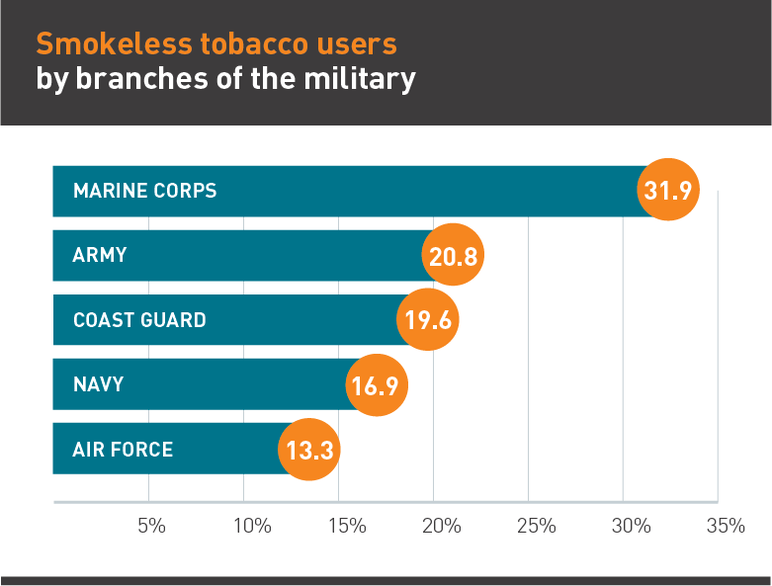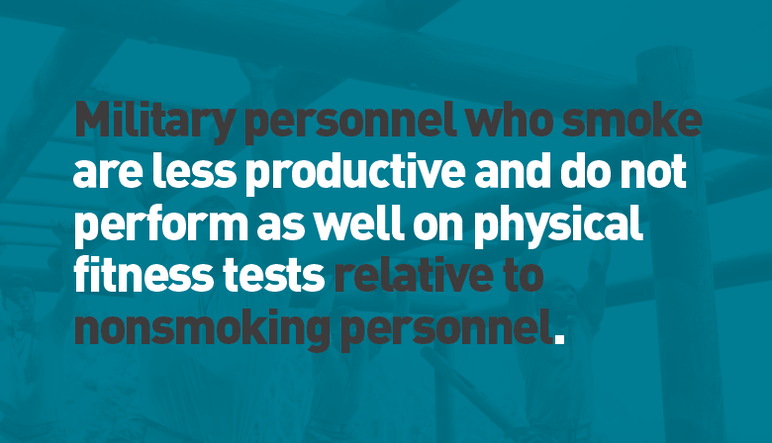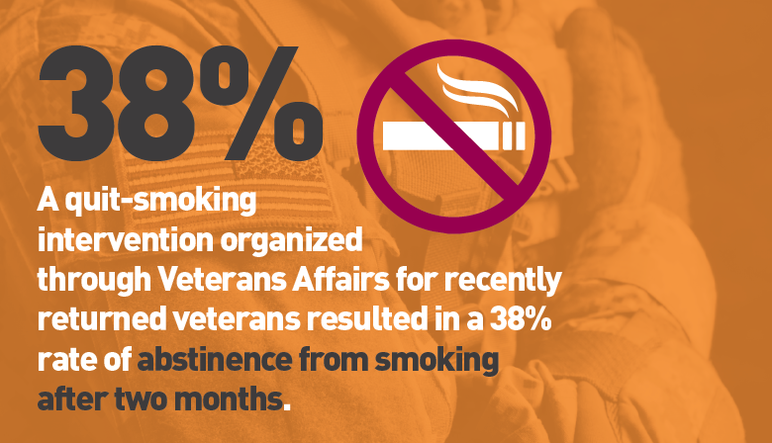Tobacco use in the military
The U.S. military has a culture of tobacco use, which decades of tobacco industry targeting has helped create and support. This culture has driven smoking rates to be significantly higher among service members than the rest of the population and impaired military readiness.

Prevalence and Trends
- In 2011, the most recent year data are available, 24 percent of military personnel smoked, compared with 19 percent of the civilian population who smoked at that time.
- Of all branches of the military, members of the Marine Corps reported the highest percentage of smokers (30.8 percent), followed by the Army (26.7 percent), Navy (24.4 percent), Coast Guard (19.9 percent) and the Air Force (16.7 percent), which has the lowest percentage of smokers.
- Twenty-five percent of men and 17.8 percent of women in the military were smokers in 2011.
- There is an inverse relationship between smoking in the military and pay grade; the lowest paid military personnel had a much higher smoking prevalence than the highest paid officers.
- In a survey, 19.5 percent of military personnel reported using smokeless tobacco. The Marine Corps reported the highest rate of smokeless tobacco use (31.9 percent), compared with those in the Army (20.8 percent), Coast Guard (19.6 percent), Navy (16.9 percent) and Air Force (13.3 percent).
- Among military members, males, whites, non-Hispanics and those with a high school education or less had higher percentages of heavy smokers compared with females, other racial/ethnic groups and personnel with some college or more education.
- The risk of starting to smoke for military members is nearly twice as likely among males and those ages 18 to 29, compared with females and adults aged over 45.

Smoking Initiation in the Military
Studies indicate that military recruits are particularly vulnerable to smoking initiation and that smoking rates increase between recruitment and active duty.
- A 2016 Department of Defense study found that 38 percent of current smokers in the military began smoking after joining. Among junior enlisted personnel, about 30 percent report current cigarette smoking after joining the military.
- Military deployment is associated with starting to smoke and, more strongly, with continuing to smoke, particularly among those with prolonged deployments, multiple deployments or combat exposures.
- A 2011 study of U.S. military members by the Department of Defense found that combat exposure significantly increases smoking initiation. Nonsmokers had 60 percent higher odds of starting to smoke after deployment and past smokers had 30 percent higher odds of resuming smoking after deployment, compared with nonsmokers and past smokers who had not seen combat.
- Across all military services, as combat exposure increases, the percentage of military members who smoke increases.

Smoke-free Policy Efforts
Despite multiple attempts in various branches to initiate smoke-free policies, no military branch is completely smoke-free.
- The Department of Defense tobacco control policy (set forth in health promotion policy directive 1010.10 and directive 1010.15) prohibits smoking in indoor facilities; however, the policy includes many exemptions. For example, indoor designated smoking areas that are “enclosed and exhausted directly to the outside, located away from air intakes and maintained under negative pressure sufficient to contain tobacco smoke” are exempted, despite a report by the surgeon general in 2006 that concluded that ventilation measures cannot eliminate secondhand smoke exposure in indoor spaces.
- Nearly 10 percent of military newspapers contain tobacco advertisements. The Air Force is the only branch that prohibits tobacco advertising in its publications. Additionally, tobacco control messages in military newspapers are less prevalent than other health issues and use less effective messaging strategies.
- In 2009, the Institute of Medicine Committee on Smoking Cessation in Military and Veteran Populations made recommendations to the Department of Defense and the Department of Veterans Affairs on strategies to reduce initiation and boost quitting among active-duty and veteran populations. To alleviate the health and financial burden of tobacco use on military personnel, retirees, families and veterans, the committee made the following recommendations:
- The Department of Defense should prohibit all tobacco use on military installations and stop selling tobacco products in commissaries and exchanges.
- Congressional requirements for designated smoking areas at Veterans Affairs health care facilities should be repealed.
- Comprehensive tobacco control programs should be implemented and their progress tracked and reported on publicly.
To date, none of these policy recommendations have been implemented.
- In April 2010, the commander of submarine forces established a policy banning smoking below decks aboard all Navy submarines. The smoking ban took effect on Dec. 31, 2010.
- In April 2012, then-Navy Secretary Ray Mabus announced that tobacco products would no longer be sold at a discount to Navy and Marine Corps personnel.
- In March 2012, the Air Force made bases around the world tobacco-free by creating “designated tobacco areas.” In March 2015, the Air Force published an updated instruction to prohibit tobacco use in installations and recreation facilities, prohibit smoking in vehicles with children and reinforce that medical campuses are tobacco-free.
- In April 2016, Defense Secretary Ash Carter approved actions to prevent initiation of tobacco use, help individuals quit using tobacco and decrease exposure to secondhand smoke. All Department of Defense facilities were directed to restrict tobacco use to outdoor areas, and areas not designated as “tobacco use areas” would be declared tobacco-free. The military branches were directed to implement plans to improve tobacco education for their personnel, strengthen programs for quitting tobacco, review efforts to institute smoke-free military housing and implement tobacco-free zones in areas frequented by children.
- In April 2017, the Navy prohibited the use, storage and charging of e-cigarettes throughout its fleet after overheating batteries caused multiple explosions.

Effects on Military Population and Readiness for Combat
Multiple studies have found a variety of adverse effects on military personnel due to smoking.
- Military personnel who smoke are less productive and do not perform as well on physical fitness tests relative to nonsmoking personnel.
- In a study on how smoking status and being overweight predict fitness levels among a military population, smoking was a stronger and more consistent predictor of fitness for duty (including physical and mental health) than being overweight.
- A recent study of young Navy female recruits found that the average number of days hospitalized was significantly longer by about half a day for those that were daily smokers compared with those who were former smokers or smoked only occasionally.
- Smoking may impair performance through direct exposure to nicotine, carbon monoxide and other tobacco smoke toxins, as well as through nicotine withdrawal.
- Exposure to carbon monoxide through smoking impairs strength and physical endurance because it reduces the capacity of blood to carry oxygen.
- Smoking has been associated with slower adaptation to the dark and lower visual awareness in dim lighting, as well as accelerated hearing loss during aging.
- Among Army men and women, the risk of being hospitalized for causes other than injury or pregnancy was 30 percent higher among men and 25 percent higher among women who smoked, respectively, than among nonsmokers.
- A large-scale study of active-duty Army men and women found that there was a 60 percent (men) and 15 percent (women) greater risk of lost workdays due to hospitalization, and a 7 percent and 54 percent greater risk, respectively, of lost workdays related to injuries among those who smoked than among nonsmokers. Lost days at work could be dangerous in combat units due to a loss of total manpower.
Quitting among Military Personnel
- Like civilian smokers, many smokers in the military report trying to quit, and, like their civilian counterparts, have difficulty quitting. In 2008, 16 percent of military personnel that were smokers in the past year had quit and 48 percent had tried unsuccessfully to quit.
- In 2011, 27 percent of infrequent smokers, 23.1 percent of light/moderate smokers and 14.9 percent of heavy smokers attempted to quit once. Additionally, 40 percent of infrequent smokers, 9.8 percent of light/moderate smokers and 7.3 percent of heavy smokers attempted to quit twice or more.
- Among military personnel, infrequent smokers report more quit and reduction attempts than light/moderate smokers and heavy smokers.

- A quit-smoking intervention organized through Veterans Affairs for recently returned veterans resulted in a 38 percent rate of abstinence from smoking after two months. Through the program, participants were referred to the National Cancer Institute quit line and offered local Veterans Affairs pharmacological treatment.
- TRICARE, the health care program for members of the military, military retirees and their dependents, covers prescription and over-the-counter quitting medications at no cost to military personnel. It also provides counseling, quit lines and web-based quit assistance.
A Culture that Encourages Tobacco Use
- When asked about quitting smoking, soldiers believed that one needed to be motivated to quit or “leave the Army” to be successful, given the availability of tobacco and the frequency of use by other soldiers.
- Focus groups with junior enlisted personnel revealed that they believed that even though the military has placed bans on tobacco, smoking was still very convenient and was even encouraged through smoking breaks, designated smoking areas and cheap tobacco products sold at military installations. Smoking was also seen as a way to deal with stress and boredom, and avoid weight gain.
- Until April 2017, tobacco products were sold at discounted rates on military bases. While the allowed discount was supposed to be 5 percent below local prices, one study found that the discounts were often much more than that, with as much as a 73 percent discount and a mean discounted rate of 25 percent on base, compared with prices at surrounding off-base stores. Now, tobacco products cannot be sold at prices less than the most competitive price in the local community. There are currently no data available to assess how well this policy is being enforced at military bases.

Industry Targeting and Marketing
Documents reveal that the tobacco industry has targeted the military for decades, using unique strategies to reach this market.
- According to industry documents from the 1970s, tobacco companies targeted the military as potential consumers, stating “subjective reports have often indicated that persons entering stressful situations, e.g., starting a new job or entering the military, frequently either start to smoke or increase their rate of smoking.” They indicated “a possible hypothesis could be the military market may be a predictor of the future or better yet, used to develop the future.”
- In the 1970s, tobacco companies recognized that a “significant feature of this market is the fact that it is governed by youth who ultimately set trends worldwide which eventually ‘spill over’ to the civilian market as these military people return to the civilian market.”
- An internal document from the 1980s revealed the industry’s interest in the military community, which it described as having the “classic downscale profile” of being “less educated,” “part of the wrong crowd,” “in trouble with authorities” and having “limited job prospects.”
- Tobacco companies described the military market as a “captive audience, due basically to the self-imposed confinement of the military family to on-base activities.”
- In 1982, Big Tobacco proposed a military music program that “meets the soldier on his own turf with an activity he can relate to and enjoy at no cost.” Big Tobacco said “KOOL is consciously associated with a good time enjoyed by young adults in an upbeat moment.”
- According to a 1983 Newport internal planning document, “there isn’t a market in the country that has the sales potential for Newport like the military market,” adding “the plums are here to be plucked.”
- In the 1980s and 1990s, the industry used various tactics to target military wives, like sponsoring bingo nights on base at clubs, giving out cigarette coupons and prizes and advertising in free on-base magazines.
- The industry lobbies to prevent the passing of tobacco control policies in the military.
- The 2015 National Defense Authorization Act, which ended discount sales of tobacco products at commissaries and exchanges, also prohibited any new policy that would ban the sale of tobacco products within the defense retail systems or on any Department of Defense vessel at sea. Representative Duncan Hunter, R-C.A., lobbied hard against the move to end discounts of tobacco products and was the author of the language to prevent new policies.
Action Needed: Tobacco use in the military
Members of the military face unique challenges in their battle against tobacco use, including prolonged deployments, cultural pressures and access to cheap tobacco products. Reducing tobacco use in the military is a critical step in protecting the health of the men and women who protect us:
- All branches of the military should establish comprehensive smoke-free policies, including in all military buildings, housing and vehicles.
- The military should eliminate discounts for tobacco products on all bases, and, to the extent possible, limit or prohibit the sale of tobacco products on base.
- The military should establish policies to discourage the use of tobacco and de-normalize tobacco use in military culture, including eliminating smoke breaks. Because smoking has been listed as a way for military members to reduce the stress of military life, the Department of Defense should determine and encourage other ways for members of the armed forces to relieve their tension and anxiety.
- Other branches of the military should follow the lead of the Air Force and not accept tobacco advertising in military publications.
- The military should ensure the strongest tobacco quit benefits for members and their families, including making available all seven Food and Drug Administration-approved medications and all three types of counseling (individual, group and phone).

More in targeted communities
Want support quitting? Join EX Program
By clicking JOIN, you agree to the Terms, Text Message Terms and Privacy Policy.
Msg&Data rates may apply; msgs are automated.


